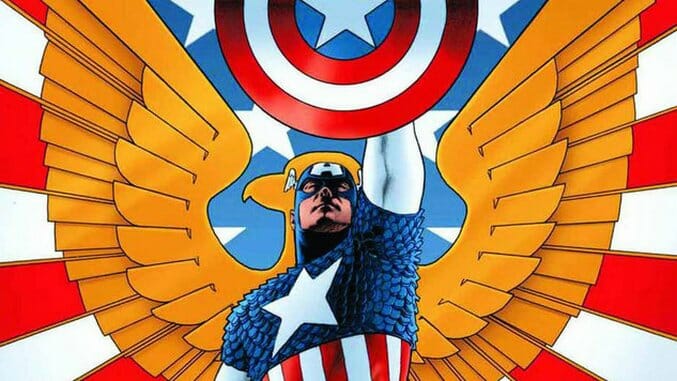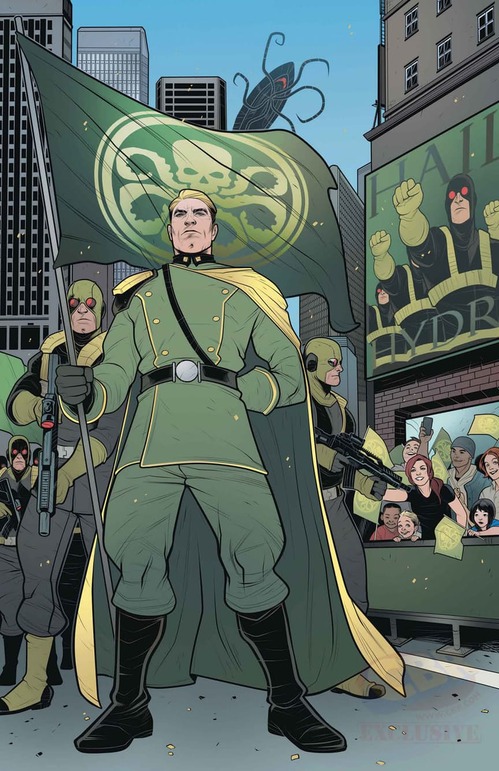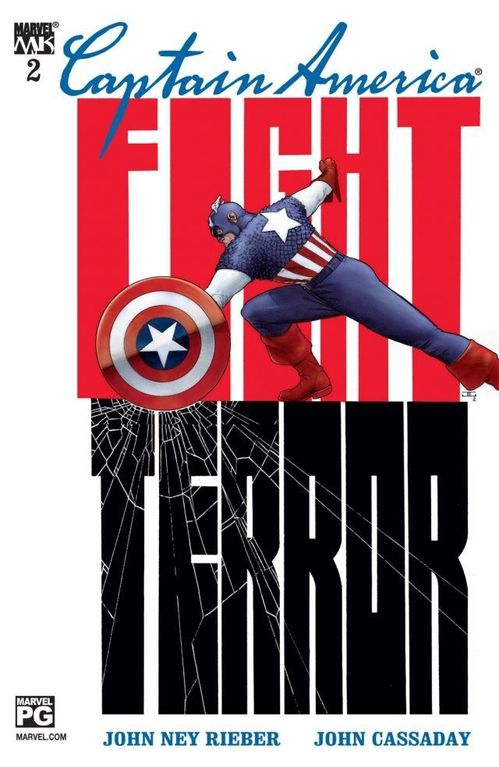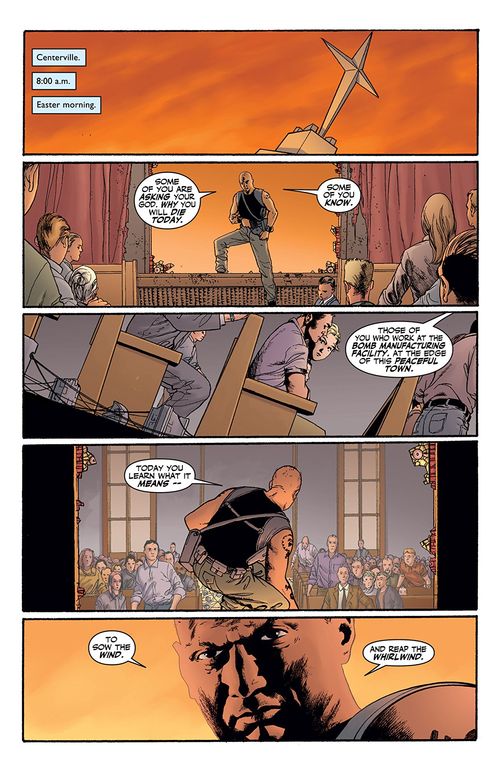Captain America’s Secret Empire and How Real-World Politics Fail in Comic Book Fantasy
Main Image by John Cassaday Comics Features Captain America
A common thread throughout discussions of Howard Chaykin’s The Divided States of Hysteria, his new Image Comics series in which the veteran firebrand cartoonist employs intentionally offensive tropes and violent imagery, and the Nick Spencer-scripted Secret Empire storyline at Marvel, which focuses on the rise of a fascist organization led by Captain America, is the idea that artists have a responsibility to reflect current issues in their work. While Chaykin purports not to read any direct criticism, statements on behalf of Image Comics have breathlessly praised The Divided States of Hysteria for making readers “both angry and uncomfortable,” while Spencer often takes to Twitter to push back against pure escapist fantasy in times of real-world distress. Readers, or at least retailers, seem to agree with Spencer: based on the limited sales data available to the public, Secret Empire is falling short of previous Marvel “events” while still clinging to the top tier of monthly sales charts, even as the Spencer-written tie-in series Captain America: Steve Rogers and Captain America: Sam Wilson under-perform relative to prior Captain America volumes.
Spencer’s intentions may well be noble; it’s undeniable that fascist ideologies are on the rise in America, fueled by a political party that spent eight years stoking anti-government and anti-liberal resentment only to find itself in control of every branch of the government and unsure what to do when unable to effectively play the victim. Waking up to find that America-the-idea has become openly hateful, no longer masked with a hopeful veneer to hide longstanding bigotry, is not a distant fiction for millions of Americans. Spencer’s authorial acrobatics to establish that Steve Rogers pledges allegiance to a Nazi-inspired and formerly Nazi-allied organization that is not itself a form of Nazism may feel too close to home in a political moment infected with the “alt-right” and its troll army of meme-deploying white nationalists.

Captain America: Steve Rogers #17 Cover Art by Elizabeth Torque
But if Secret Empire, which is approaching the heroic-resistance portion of its saga, falls short in its quest to Say Something Important about the state of the country, it’s only the latest of Captain America’s well-intentioned stumbles. The history of the character is littered with attempts at political relevance that haven’t succeeded. A previous “Secret Empire” storyline, published in 1973 during the height of Richard Nixon’s Watergate scandal, implied that the leader of a fascist organization attempting a U.S. government coup was the POTUS himself; he commits suicide on the White House lawn rather than face capture. In the fallout of the storyline, Steve Rogers briefly doffs the Captain America identity to become Nomad, a man without a country. Often left unmentioned is that this storyline involves a plot by the Secret Empire to kidnap mutants and harness their powers to fuel a flying saucer—not exactly the stuff that Woodward and Bernstein made their names exposing.

Captain America #175 Interior Art by Sal Buscema
As often as writers feel compelled to thrust superheroes into storylines of grand importance, this tightrope walk of suspended disbelief often prevents well-intentioned emotional gravitas. Captain America: The New Deal, the first collection of Marvel’s post-9/11 mature-readers Captain America series, opens with the moments leading up to a plane hijacking before shifting to a dazed, but determined, Steve Rogers, out of uniform, moving rubble from Ground Zero in search of survivors. Colorist Dave Stewart renders the whole scene in shades of gray, enveloping Rogers and the reader in a haze of dust. It’s a somber sequence, and showcases the inherent goodness of Rogers; more than a symbol, Captain America is a man who loves his country and its people. It’s not until Rogers stumbles across an attempted hate crime against a Muslim-American that he dons his star-spangled duds, and apparently all it takes to rid a hateful mob of its misdirected rage is a flash of the flag’s iconic colors.

Captain America Cover Art by John Cassaday and Dave Stewart
Writer John Ney Reiber and artist John Cassaday produce some genuinely stunning pages throughout the six-issue arc, particularly via Reiber’s second-person narration and Cassaday and Stewart’s awe-inspiring artistic combination (easily some of Cassaday’s best work), but the plot falls apart with any examination. Within a year of 9/11, terrorists of murky origin attack the middle-American city of “Centerville” (subtle), where Americans feed their children by working in factories producing the parts that will assemble bombs that drop across the Middle East, killing and maiming other people’s children. The terrorists, including the field commander Rogers reluctantly kills on live TV and the ringleader who pontificates later in the story, make clear Rogers’—and by extension, America’s—culpability in inspiring acts of terror. The second-person narration hammers home that we are all, through the freedoms we take for granted, guilty of benefiting from the landmines that litter foreign soil and the destabilization committed in the name of global good. There is even an implication that S.H.I.E.L.D., Marvel’s Big Brother-esque global peacekeeping taskforce, allows the terrorist attack on American soil as a means of testing new military technology—a never-concluded analogue of “Bush did 9/11.”

Captain America The New Deal Interior Art by John Cassaday and Dave Stewart
But for all the prepackaged Inspiring Moments™ in this arc, including Captain America clinging to a burning American flag as fireworks ring out above the Potomac, the reality of terrorism and American culpability is not a concept that fits easily within the Marvel Universe. Marvel’s New York City is stuffed with super-powered individuals who regularly face down threats ranging from giant purple world-eaters to metal-clad Eastern European despots to magnetically powered mutant supremacists, all of whom have been implied to regularly wreak havoc on or beyond the scale of 9/11. Saving planes is a textbook example of heroism, one so common as to become an oft-parodied trope. Although it feels taboo to debate, the idea that terrorist attacks like 9/11 could occur in a world full of Avengers, X-Men and various other heroes is doubtful—what good are superpowers, after all, if they can’t counter all-too-human hatefulness?
Even the history of the other current Captain America, former Falcon Sam Wilson, is full of awkward and conflicting attempts at relevance. Is Wilson a former social worker doing his best to help his Harlem community, or was he gang-leader and professional criminal “Snap” Wilson? Depending on your understanding of the reality-altering Cosmic Cube, Wilson has been both, and a troubling example of Marvel’s difficult history with black social relevance, a topic perhaps best explored by the quickly cancelled Nighthawk series and its unflinching look at anti-black police violence. Spencer himself has stumbled in his portrayal of Wilson, using the character’s solo title to take potshots at so-called “social justice warriors” or “slacktavists” in a cringe-inducing sequence that missed the mark for many readers.

Captain America Sam Wilson #17 Interior Art by Paul Renaud
It’s no mistake that the best-remembered Captain America run in recent history, Ed Brubaker’s tenure, took much of its inspiration from Cold War-era spy thrillers, not contemporary headlines. Brubaker and artist Steve Epting’s creation Aleksander Lukin, a former KGB operative, runs a massive corporation that throws its weight around politically—an all-too-real threat in modern-day America—but despite storylines called “The Death of the Dream” and “The Man Who Bought America,” Brubaker and his artistic collaborators are most concerned with Steve Rogers the man, not Steve Rogers the flag-clad stand-in for America. Brubaker surely took inspiration from political reality, but largely with the benefit of chronological distance from his source material.
None of this is to imply that comics, or any art form, cannot or should not tackle difficult social topics. The aforementioned Nighthawk was a brief but potent example of Marvel’s potential to address real-world issues through costumed antics, and series like Marjorie Liu and Sana Takeda’s Monstress, Tom King and Gabriel Hernandez Walta’s Vision and Jeff Lemire and Greg Smallwood’s Moon Knight prove that there is ample space within fantasy storytelling to process themes like human trafficking, post-traumatic stress disorder and mental health, respectively. Captain America, for whatever reason, has rarely occupied that space with much success. Perhaps it’s the necessarily micromanaged status of a corporately owned pop icon, the weight of expectations heaped on a hero made to represent an increasingly divided country or merely a lack of distance/perspective from those at the creative helm, but Steve Rogers’ most politically resonant moment likely remains his debut from creators Jack Kirby and Joe Simon, way back in 1941, in a moment that still feels relevant and important today: punching Hitler in the face.
